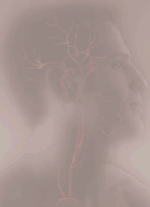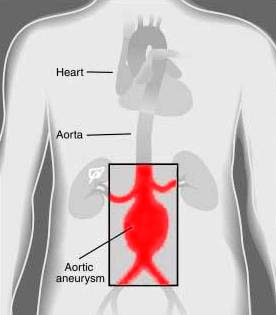

 |  |
ANNUAL SCREENINGS FOR VASCULAR DISEASE
The University Vascular Center at Stony Brook provides annual free screenings for carotid (neck) artery disease and abdominal aortic aneurysm, as well as screening for peripheral vascular disease. These screenings are designed to promote awareness of vascular disease, identify signs and symptoms of disease, and reduce the risk of atherosclerotic disease and abdominal aortic aneurysm by improving general health.
For Carotid Artery Disease and Stroke Risk Factors

![]() This screening involves a non-invasive, 15-minute ultrasound test to
detect build-up of plaque in the carotid (neck)
arteries. Our chief of vascular surgery Dr. Apostolos Tassiopoulos,
associate professor of surgery, says: "Stroke and cardiovascular disease are the
number one killers of older people in this country, and
many of those deaths can be prevented. This test allows
us to determine if an individual is at risk because of a
plaque build-up and then to treat that individual to
reduce the risk factor."
This screening involves a non-invasive, 15-minute ultrasound test to
detect build-up of plaque in the carotid (neck)
arteries. Our chief of vascular surgery Dr. Apostolos Tassiopoulos,
associate professor of surgery, says: "Stroke and cardiovascular disease are the
number one killers of older people in this country, and
many of those deaths can be prevented. This test allows
us to determine if an individual is at risk because of a
plaque build-up and then to treat that individual to
reduce the risk factor."
For Presence of Abdominal Aortic Aneurysm

![]() This screening uses the same non-invasive ultrasound test to detect the presence of abdominal aortic aneurysm (AAA). An AAA is a weak area in the wall of the abdominal aorta—the artery that carries blood from the heart to the rest of the body.
This aorta is the body’s largest blood vessel; when an area is weak, it may bulge like a balloon when blood flows through it. Undiagnosed ruptured AAAs are responsible for many cases of sudden death in older persons.
This screening uses the same non-invasive ultrasound test to detect the presence of abdominal aortic aneurysm (AAA). An AAA is a weak area in the wall of the abdominal aorta—the artery that carries blood from the heart to the rest of the body.
This aorta is the body’s largest blood vessel; when an area is weak, it may bulge like a balloon when blood flows through it. Undiagnosed ruptured AAAs are responsible for many cases of sudden death in older persons.
The most common cause of an aortic aneurysm is atherosclerosis (often called "hardening of the arteries"). Atherosclerosis is a gradual process in which cholesterol and scar tissue build up, forming a substance called "plaque" that weakens or damages the walls of the blood vessels and makes them more vulnerable to an aneurysm. Other risk factors are high blood pressure, smoking and a family history of AAA. Less frequently, aneurysms may be caused by connective tissue diseases, inflammation of the blood vessels (vasculitis) and some congenital disorders. Aortic aneurysms most frequently occur in white males between the ages of 50 and 60.
Stony Brook's vascular surgeons are among the few in Suffolk County who provide minimally invasive endovascular repair of AAA.
For Peripheral Vascular Disease
This screening uses non-invasive blood pressure tests to detect risk factors for potentially limb-threatening peripheral vascular disease (PVD)—that is, blockage of blood flow in your legs. Early detection is key to avoiding loss of limbs (amputation), as well as life-threatening cardiovascular disease.
Your answers to the following questions will help you know if you are at risk for PVD:
n Are you over age 55?
n Do you have cardiovascular (heart) problems such as high blood pressure, heart attack, stroke?
n Do you have diabetes?
n Do you have a family history of diabetes or cardiovascular problems (immediate family such as parent, sister, brother)?
n Do you have aching, cramping or pain in your legs when you walk or exercise, but then the pain goes away when you rest?
n Do you have pain in your toes or feet at night?
n Do you have any ulcers or sores on your feet or legs that are slow in healing?
n Do you smoke?
n Have you ever smoked?
n Are you more than 25 pounds overweight?
n Do you eat fried or fatty foods three times a week or more?
n Do you have an inactive lifestyle?
The more "yes" answers you have, the more important it is for you to have an evaluation for possible PVD.
 To find out when and where our annual vascular screenings will next be provided, please call Stony Brook's HealthConnect at 631-444-4000, or look for notices in local newspapers.
To find out when and where our annual vascular screenings will next be provided, please call Stony Brook's HealthConnect at 631-444-4000, or look for notices in local newspapers.
